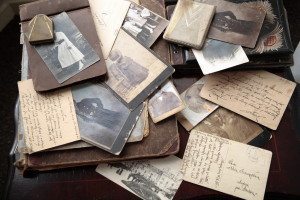Genealogy Mysteries: Identifying Old Family Photos

Nothing brings genealogy to life for researchers like staring into the face of a long gone ancestor. Often, it’s a small detail – perhaps the expression on their face or the resemblance that they bear to a loved one. Regardless of what captured your interest, old family photos are a treasure that helps connect past and present generations. They can hold even more meaning if you’re able to identify who is featured in the photograph. Here are five strategies that researchers can use to learn more about who might have been captured in family photographs.
Look for written clues and ask older relatives
In some cases, identifying a family photo may be as simple as flipping it over. Start your search for more information by looking on the photograph itself – including the back – for details. Names, dates, or locations can all be helpful even if you aren’t able to make an immediate association between that information and a specific person. Another strategy is asking older living relatives, who may recall what certain ancestors looked like or have seen the photos before.
Consider the context
Archeologists discuss “context” when learning more about the artifacts that they uncover. Basically, where was the item when it was found? In the case of family photos, context could refer to an album that might contain written information beneath or near the photo. It can also be helpful to note which photos are near each other, as there may be relationships between the people or they could be chronological photos of the same person. If the photos were uncovered in another way such as near specific letters or papers, the proximity between documents may offer clues.
Determine the type of photo
Photography has evolved significantly since it first developed. Understanding what type of photograph an image is offers hints as to the period it was taken. Daguerreotypes were common from 1839 until the early 1870s. Cabinet cards were more common from 1866 until the early 20th century. Color photos weren’t typically available until the 1940s, and weren’t widely available until the 1960s. A photography expert can help you determine what type of photograph you’ve got.
Look for a photographer’s imprint
Many photographers listed details on their work such as their name, business name, city, or an imprint (like a logo) of their business on each image they took. Check the image front and back, as well as any case or frame, for this information. If you can find it, researching details of the business can give you signs regarding the time period and location that the photograph was taken.
Play visual detective
Another way to gather information regarding family photos is to play visual detective. What can you learn about the people in the photo by looking at the scene and setting? Was the image taken at a hard scrabble farm, for example, or in a lush sitting room? Focusing on personal details of the people in the picture such as hair style, clothing, specific clothing styles and jewelry can also provide insights into when a photograph was taken. Any belongings or decorations in the picture can also be helpful.
With all this information, you’ll often be able to narrow down the time period, general life circumstances, and other information of the people in your family photographs. Compare this information to the other details you have, and you’re likely to make important progress in identifying who is in the photo – or at least developing a hypothesis. Do you need assistance with research related to visual evidence or other genealogy projects? Contact Price and Associates today to arrange for a personalized consultation.
